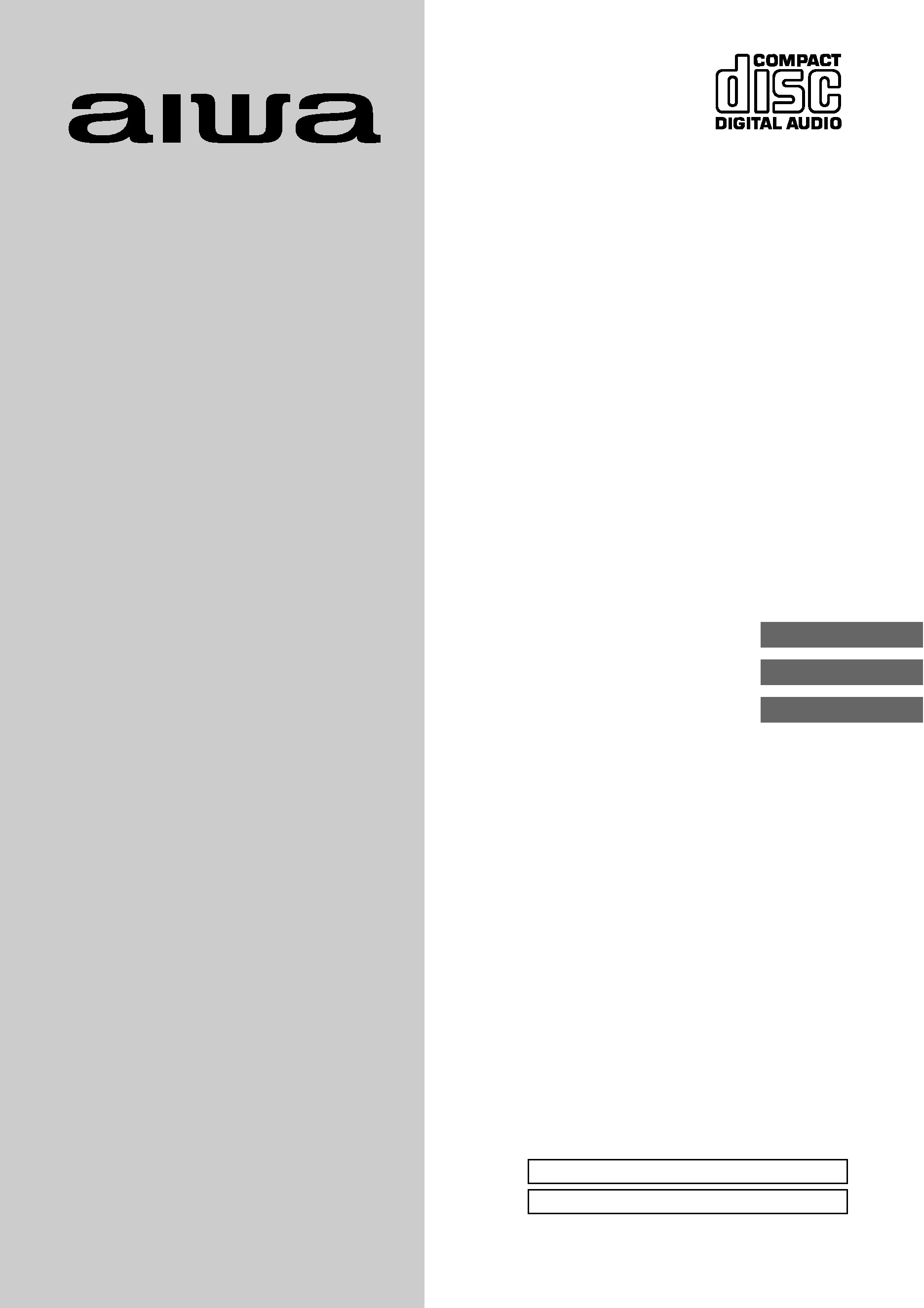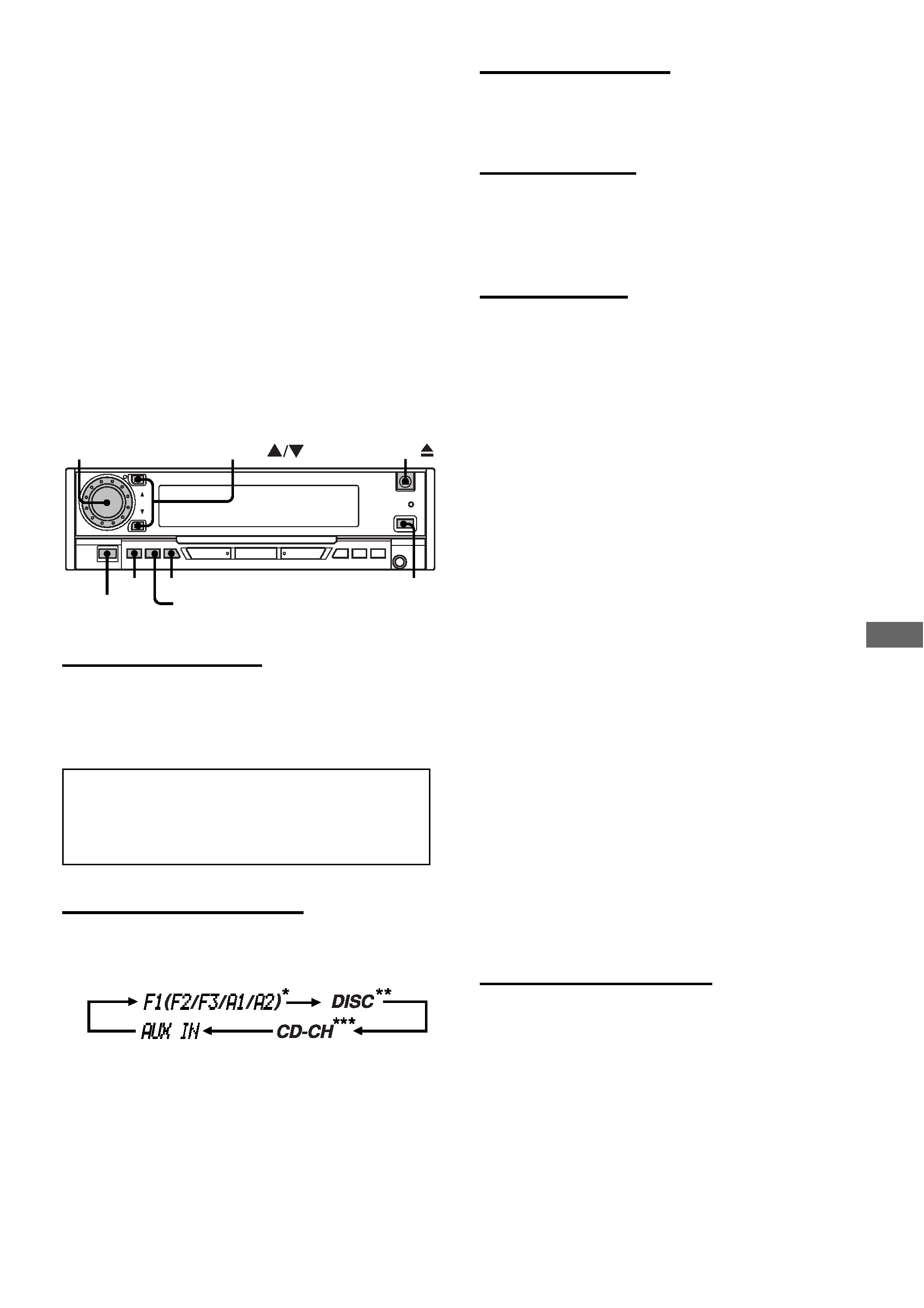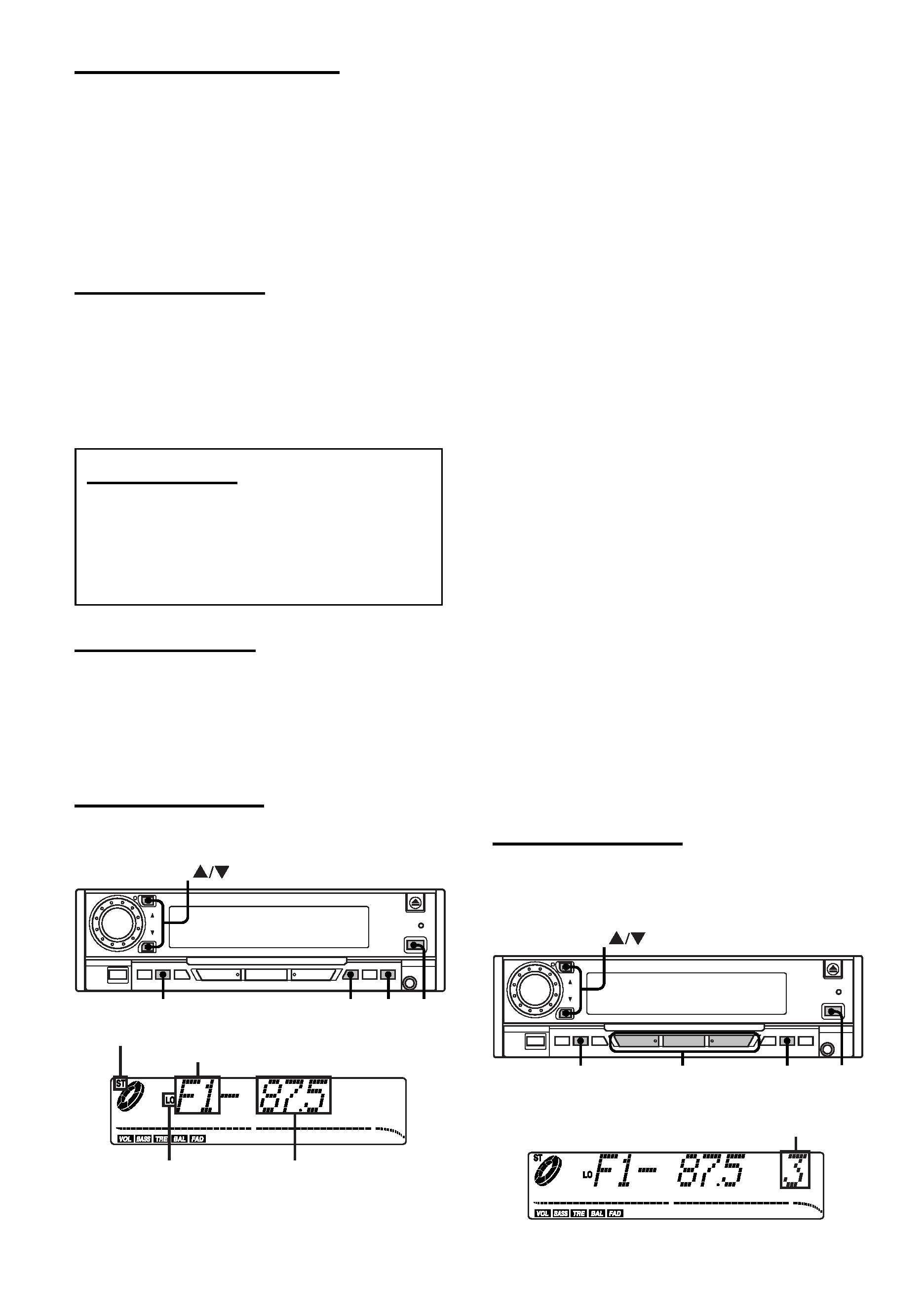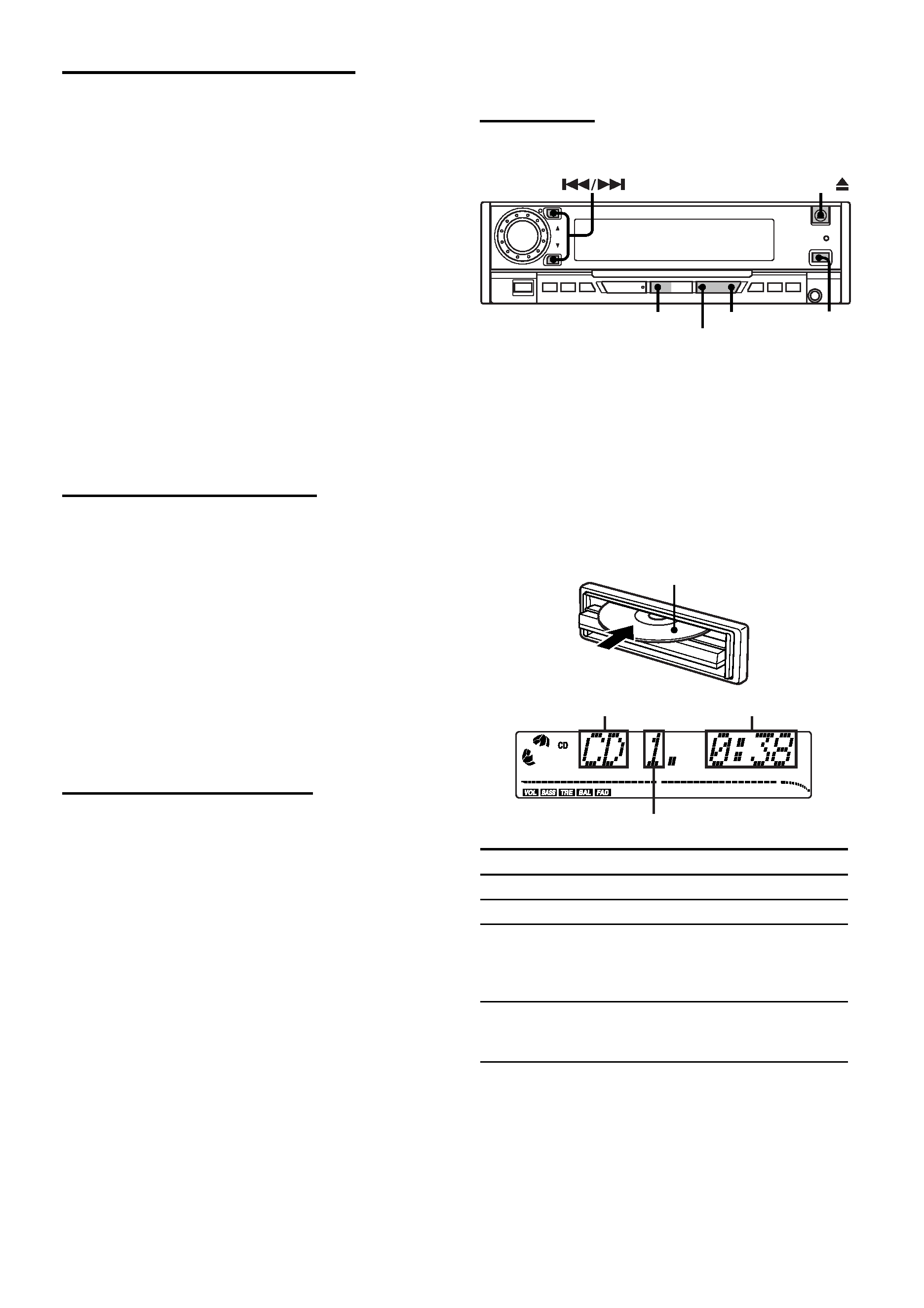
8C-KC4-901-01
020131ATM-OX
CDC-X927M YUC
STEREO CAR CD RECEIVER
RADIO-TOCADISCOS DE CD ESTEREOFONICO PARA
AUTOMOVIL
ENGLISH
ESPAÑOL
FRANÇAIS
OPERATING INSTRUCTIONS
MANUAL DE INSTRUCCIONES
MODE D'EMPLOI
OWNER'S RECORD
For your convenience, record the model number and
serial number (you will find them on the bottom side of
your set) in the space provided below. Please refer to
them when you contact your AIWA dealer in case of
difficulty.
Model No. CDC-X927M
Serial No.

TABLE OF CONTENTS
THEFT PROTECTION .............................................. 2
BASIC OPERATION, AUDIO AND CLOCK
ADJUSTMENT ..................................................... 2
RADIO OPERATION ................................................. 3
CD PLAYER OPERATION ........................................ 4
AUXILIARY EQUIPMENT ......................................... 5
OTHER FUNCTIONS ............................................... 5
CARD REMOTE CONTROL ..................................... 6
CD CHANGER OPERATION .................................... 7
TROUBLESHOOTING .............................................. 7
MAINTENANCE ........................................................ 8
SPECIFICATIONS .................................................... 8
CD Notes
· Playing a defective or dusty CD can
cause dropouts in sound.
· Hold CDs as illustrated.
· Do NOT touch the unlabeled side.
· Do NOT attach any seal, label or data
protection sheet to either side of a
disc.
· Do NOT expose a CD to direct sunlight or excessive
heat.
· Wipe a dirty CD from the center outward with a cleaning
cloth.
Never use solvents such as benzine or alcohol.
· This unit cannot play 3-inch (8 cm) CDs.
· NEVER insert a 3-inch CD contained in the adapter or
any irregularly shaped CD.
The unit may not be able to eject it, resulting in a
malfunction.
DEMO (Demonstration) mode
The unit has an extra display mode, which demonstrates
the display of the operation modes of the unit. The unit
switches to DEMO mode automatically if you turn the
unit on and leave it as it is for 5 seconds after all the
connections have been completed.
To cancel DEMO mode
1 Press and hold SRC until "CONT." appears on the
display.
2 Press TUNE i or TUNE k until "DEMO." appears
on the display.
3 Turn AUDIO CONTROL to select "DEMO. OFF".
To resume DEMO mode, select "DEMO. ON" in step 3.
1 ENGLISH
PRECAUTIONS
· Use only in a 12-volt DC negative-ground electrical
system.
· Disconnect the vehicle's negative battery terminal
while mounting and connecting the unit.
· When replacing the fuse, be sure to use one with an
identical amperage rating. Using a fuse with a higher
amperage rating may cause serious damage to the unit.
· Do NOT attempt to disassemble the unit. Laser beams
from the optical pickup are dangerous to the eyes.
· Make sure that pins or other foreign objects do not get
inside the unit; they may cause malfunctions, or create
safety hazards such as electrical shock or laser-beam
exposure.
· When your vehicle has been parked in direct sunlight
resulting in a considerable rise in the temperature
inside, allow the unit to cool off before operating it.
· Keep the volume at a level at which you can hear
outside warning sounds (horns, sirens, etc.).
NOTE
This equipment has been tested and found to comply
with the limits for a Class B digital device, pursuant to
Part 15 of the FCC Rules. These limits are designed to
provide reasonable protection against harmful
interference in a residential installation.
This equipment generates, uses, and can radiate radio
frequency energy and, if not installed and used in
accordance with the instructions, may cause harmful
interference to radio communications. However, there
is no guarantee that interference will not occur in a
particular installation. If this equipment does cause
harmful interference to radio or television reception,
which can be determined by turning the equipment off
and on, the user is encouraged to try to correct the
interference by one or more of the following measures:
-- Reorient or relocate the receiving antenna.
-- Increase the separation between the equipment
and receiver.
-- Connect the equipment into an outlet on circuit
different from that to which the receiver is connected.
-- Consult the dealer or an experienced radio/TV
technician for help.
CAUTION
Modifications or adjustments to this product that are not
expressly approved by the manufacturer may void the
user's right or authority to operate this product.
1 ENGLISH
In addition to ordinary CDs, CD-Rs or CD-RWs can
be read by this unit. However, NEVER use a CD-R or
CD-RW that contains no data or data in the wrong
format, such as MP3 or other computer files.

THEFT PROTECTION
(Retractable Front Panel)
When your car's ignition switch is turned off, the front
panel will be retracted automatically as if there were no
car audio in the console.
When the ignition switch is set to ACC or ON position,
the front panel will appear automatically.
Note
Do not touch and put excessive pressure on the front
panel while it is rotating.
BASIC OPERATION,
AUDIO AND CLOCK
ADJUSTMENT
PWR/MUTE
BAND
SEL
DISP
SRC
AUDIO CONTROL
TUNE
EJECT
Turning the unit on/off
· You can turn the unit on by pressing any button on the
front panel except
z. The unit also turns on when you
press
z and insert a CD.
· Press and hold PWR/MUTE until the unit turns off.
Note
Most operations described in this manual require
the unit to be turned on before starting the operation,
unless explicitly stated otherwise.
Changing the source mode
1 Press SRC.
Pressing SRC cycles through source modes in the
following order:
* To select another bands, press BAND to select F2,
F3, A1, A2, while "F1" is displayed.
** "DISC" does not appear on the display when there is
no CD in the unit.
***CD Changer Play mode (available when an optional
CD Changer is connected)
ENGLISH
2
ENGLISH
2
ENGLISH
Adjusting the volume
1 Turn AUDIO CONTROL.
VOL (volume) indication appears.
Muting the sound
1 Press PWR/MUTE briefly.
MUTE indicator flashes.
To restore volume, briefly press PWR/MUTE again.
Adjusting sound
You can select the following modes for adjusting sound
depending on the music you listen to: BASS (low
frequencies), TRE (high frequencies), BAL (left/right),
FAD (front/rear), H-BASS (high bass)*, DSSA (Drivers
Sound Stage Adjustment)** and BBE***.
*
You can reinforce the bass sound.
** You can adjust sound stage and tone balance to best
serve a particular seat in the car.
*** You can enhance the clarity of high-frequency sound.
1 Press SEL repeatedly to select the mode to be
adjusted.
Pressing SEL cycles through the modes. The
selected mode's indicator appears.
2 Turn AUDIO CONTROL to increase or decrease
the level for the selected mode (except for H-BASS,
DSSA and BBE).
In H-BASS mode, turn AUDIO CONTROL to select
1, 2, 3, or OFF.
In DSSA mode, turn AUDIO CONTROL to select L
(for the front left seat), R (for the front right seat), or
OFF.
In BBE mode, turn AUDIO CONTROL to select 1,
2, or OFF.
Notes
· Adjust the level or select an item within 5 seconds, or
the selected mode will return to previous state.
· When DSSA is activated, you cannot adjust BAL, FAD,
BASS, TRE and BBE.
· When BBE sound is activated, you cannot adjust
BASS and TRE.
Aligning the source levels
(Source Level Adjuster)
Volume may vary each time you change the source
mode. In this case, you can align each source mode's
volume to almost the same level.
1 Press SRC repeatedly to select the desired mode.
2 Press DISP while pressing SEL.
"LEVEL 0" appears on the display.
3 Turn AUDIO CONTROL to adjust the level.
Note
Adjust the level within 5 seconds, or this function will be
canceled.

1 Press BAND repeatedly to select the desired band
(F1, F2, F3, A1 or A2).
2 Press TUNEi (to move to higher frequencies) or
TUNE
k (to move to lower frequencies) to tune in to
a station.
"ST" appears on the display when an FM station is
broadcasting in stereo, and receiving conditions are
good.
Seek Tuning and Manual Tuning
· Press and hold TUNE
i or TUNEk until Seek
Tuning starts.
The unit locates a station automatically (Seek
Tuning).
· Press TUNE
i or TUNEk repeatedly to search for
a desired station while increasing or decreasing
the frequency step by step (Manual Tuning).
To stop Seek Tuning, press TUNE
i or TUNEk
again.
Monaural mode
When FM signals become weak, or FM reception
becomes poor, the unit automatically switches to
Monaural mode to reduce noise.
Note
When stereo sound is received, you can also press ST
and select "MONO ON" to listen in manaural mode.
To resume stereo sound receiving, press ST to "MONO
OFF".
Local mode
Local mode allows you to tune in only to strong stations
during Seek Tuning.
1 Press LO before you start seek tuning.
"LO" appears on the display.
To return to Distant mode, press LO again.
"LO" disappears and the unit tunes in to all receivable
stations.
Using preset stations
You must preset stations before you can tune in to a
station using preset station number buttons.
PS/A.ME
BAND
SRC
TUNE
3 ENGLISH
3 ENGLISH
Restoring the factory settings
1 Turn off the unit.
2 Press and hold DISP until "LEVEL --" appears on the
display.
Note
You can restore the factory settings only for VOL, BASS,
TRE, BAL, FAD, H-BASS, DSSA and BBE as well as
aligned source volume levels.
Setting the beep tone
1 Turn off the unit.
2 Press and hold SEL until "BEEP" appears on the
display.
3 Turn AUDIO CONTROL to select "ON" or "OFF".
4 Press SEL.
The unit turns off.
Setting the clock
1 Press and hold DISP until the clock indicator
flashes on the display.
2 Press TUNEi (to set hour) or TUNEk (to set
minute) and turn AUDIO CONTROL.
3 Press DISP.
Displaying the clock
1 Press DISP.
To return to the former display, press DISP again.
RADIO OPERATION
Tuning in to a station
(Seek/Manual Tuning)
LO
ST
BAND
SRC
TUNE
Local indicator
Frequency indication
* "F" means FM, and "A" means AM.
Stereo indicator
Band indicator*
Preset station number
Preset station
buttons 1 6

Presetting stations automatically
(Auto Memory)
1 Press BAND repeatedly to select the desired band
(F1, F2, F3, A1 or A2).
2 Press and hold PS/A.ME until automatic presetting
starts. "A MEM" appears on the display.
The unit automatically stores up to 6 stations for
each band.
After completion of automatic presetting, the unit
tunes in to all the stations stored on the preset
station buttons in order (Preset Scan).
To cancel automatic presetting, press PS/A.ME again.
Checking the preset stations (Preset Scan)
1 Press PS/A.ME briefly.
Each preset station will be tuned in for 5 seconds in
order.
To cancel Preset Scan, press PS/A.ME again or any
preset station button.
Presetting stations manually
(Manual Memory)
1 Press BAND repeatedly to select the desired band
(F1, F2, F3, A1 or A2).
2 Press TUNEi or TUNEk to tune in to a desired
station (see "Tuning in to a station," page 3).
3 Press and hold the desired preset station button until
the unit beeps.
Note
A newly preset station replaces the station on the same
band that was previously stored on that preset station
button.
Tuning in to a preset station
1 Press BAND repeatedly to select the desired band
(F1, F2, F3, A1 or A2).
2 Press the preset station button on which the desired
station is stored.
Active tuning reception control (ATRC)
The unit automatically suppresses FM noise caused by
vehicle movement, and maintains sound quality.
ENGLISH
4
ENGLISH
4
CD PLAYER OPERATION
Playing a CD
You can play CDs, CD-Rs and CD-RWs using the
procedure described below.
RNDM
REP1
INT
SRC
EJECT
1 Press z to open the front panel.
2 Insert a CD.
The front panel will be closed automatically and
"CD" appears on the display.
CD play starts.
If a CD is already inserted, press SRC repeatedly to
select CD play mode.
In normal play, when the last track finishes, the unit
returns to the first track and continues to play.
* When you remove the CD, the front panel will be
closed automatically after a while.
To close the front panel manually, press
z while the
front panel is open.
To
Eject a CD
Skip to the next track
Go back to the beginning
of the current track
Each extra press skips
backward one extra track
Locate a specific point in
a track
Press
z*
t
r
Press and hold
r or
t until you find the
point.
Labeled-side up
CD indicator
Elapsed playing time
Track number
